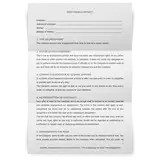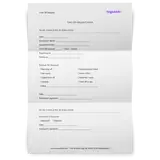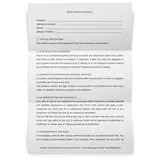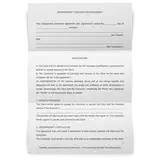For an employee evaluation template you can use at your yearly employee performance review meeting, you can download this free, print-ready Employee Performance Review template in Excel spreadsheet format.
This spreadsheet allows you to track your employee’s performance based on the metrics of twelve key employee competencies, such as teamwork and problem solving, as well as important employee performance metrics. You’ll be able to note goals for the new year, as well as marking how the employee did at meeting the goals in the previous review period.
This annual review template will allow you to neatly and clearly organize all relevant and important employee performance review information for optimal evaluation success.
What is an employee performance review?
As human resources professionals, executives, and managers in a business environment, it is part of your responsibility to manage employees' training and onboarding process, compensation, and development. As such, you directly impact the careers of many people, as well as the success of your organization.
One of the greatest tools at your disposal to help you with this job function is the employee performance review, a formal assessment in which managers evaluate how an employee has been performing, set goals, offer feedback, and identify areas of both strength and weakness.
Typically, these are annual performance reviews - most companies send out a performance review form annually. However, it can be more useful to send these out on a more frequent basis if you want to do effective performance reviews. For example, quarterly reviews are a good way to measure performance goals more frequently and give continuous feedback.
Benefits of employee performance reviews
The employee performance review is a powerful tool that has many notable strengths and benefits for the employee, the manager, and the company. These include, among others:
- Clearly communicating expectations of the employee’s role and performance through predefined criteria
- Assuring that the employees working for your organization are providing value to the company and meeting expectations in relation to larger goals
- Identifying areas of performance that require additional training and supervision, focusing on their professional development
- Helping give the employee feedback and direction that aid in self-improvement, self-management, and future performance measured through various rating scales
- Gathering information crucial to determining compensation and promotion
- Identifying employees who are under-performing and whose positions need to be re-evaluated
- Recording and tracking the development of employees within the organization, through methods such as peer reviews
- Giving employees the opportunity to be heard and engage in a dialogue about their position, performance, and experience
How to conduct an employee performance review
Most employee performance reviews are done on a yearly basis for the entire company at once, around the time that decisions about raises, promotions, and bonuses are made. In order for a performance review to be as successful as possible, there are several important things to keep in mind.
Be prepared
Both a manager and employee should come into the performance review prepared, with clear ideas about what they will say. For example, discussing their technical skills, communication skills or a 30-60-90 day plan for improving employee and team performance.
Managers should have their employee review form filled out ahead of time, while employees should come in with a self-evaluation completed and any materials they want to review prepared. This will save time, keep the meeting on track, and ensure that all important points are discussed.
Using an annual performance review template is a great way to evaluate job performance and facilitate the evaluation process, all the while saving time and money.
Solicit feedback
As a performance reviewer, if you are unsure of how to respond to any metric on your employee evaluation form, it is important to do your due diligence and gather the relevant information by soliciting feedback about your employee from other people that they work with, known as peer feedback.
In fact, this is a useful step in any case, as it will reduce bias and ensure a higher understanding throughout the performance review process. This type of meaningful feedback plays a critical role in the review process.
This helpful feedback can help employees with career development and give them a holistic review of their skill set, so they reach their future goals more easily. It also helps with realistic goal setting because peers know the individual skills of an employee really well.
From soft skills, leadership skills and core skills for the role, peer reviews are a valuable tool for unlocking new growth opportunities.
Be clear
Because employee performance reviews usually only happen on a yearly basis, it’s important that both parties walk away from the meeting with a complete, clear understanding of what has been discussed, especially insofar as it impacts compensation and promotion.
As a reviewer, it is your responsibility to speak concisely and precisely so that there are no misconceptions about your appraisal or expectations for the future. Use specific examples to illustrate your points so there is no room for misunderstanding.
Your main aim should be to offer constructive feedback that helps the performance management process. The employee should walk away with ideas for continuous improvement based on the constructive criticism given by their manager. They should know the job expectations, the future plans for the company, the development opportunities they have and the actionable steps they can take to get there.
Listen
Just as much as it is your job to make sure your employee understands what you are saying, it is equally your responsibility to have a dialogue with your employees, really listening to them. It’s important that you understand their perspective, their opinion on their own performance, and their goals moving forward.
After all, employee performance evaluations aren’t just opportunities for you to lecture or provide your own opinion. They are constructive conversations that help you highlight key achievements of an employee, discuss their career prospects and give a comprehensive overview of employee behaviors.
Ask thoughtful questions, listen closely, and make sure you allow your employee’s voice to be heard and thoughts to be taken into consideration.
This is especially important if the constructive feedback you're giving is about putting them on a performance improvement plan or taking some sort of action to improve their work. Remember, an effective review process is a two-way conversation. The employee should be able to share their thoughts about their personal goals, team goals, and more.
Provide employees with a copy of their performance evaluation form
One last important point not to forget is to make sure your employee leaves the meeting with a copy of their own employee review form. They will be able to reference it as a way to understand the feedback they received and the performance expectations in the future. They can get action items to reflect on and prepare for the next review cycle.
This way, they can always reference the action plans for the changes in their performance and make sure what they're doing aligns with the organizational goals. If you've given actionable feedback that contributes to their professional growth, this copy of detailed feedback can help drive employee engagement and performance.
Wrapping up
Whether you do annual or quarterly performance reviews, these are chances to give valuable feedback to your team and help them achieve their career goals, as well as long-term goals for your business. No matter the type of performance review, you should not be starting from scratch every time.
With our simple performance review template, you can asses employees' core competencies and skill sets for a variety of job roles. The best part is - it's completely free.
![Employee Performance Review - Free Template (Excel & PDF) [Download]](/static/image?src=https%3A%2F%2Fcdnblog.unrubble.com%2Fpayload-unrubble-images%2FEmployee-Performance-Review-Template-600x600.png&width=512&height=512&fit=contain&position=center&quality=65&compressionLevel=9&loop=0&delay=100&crop=null&contentType=image%2Fwebp)




